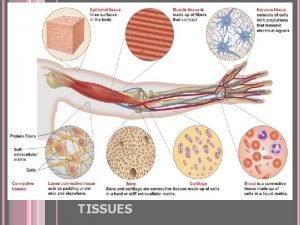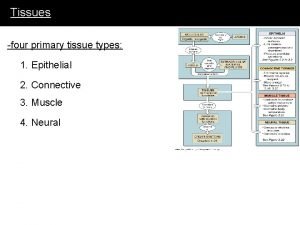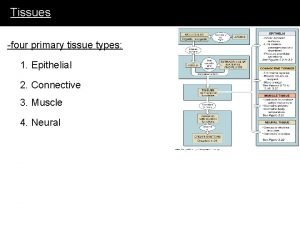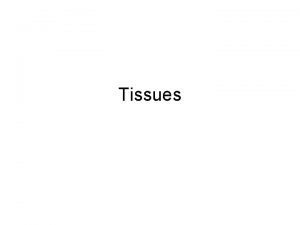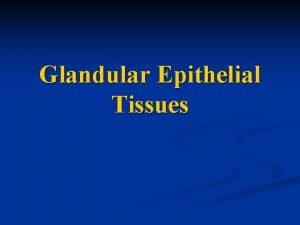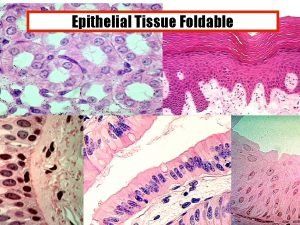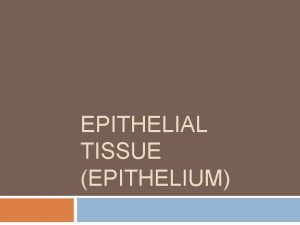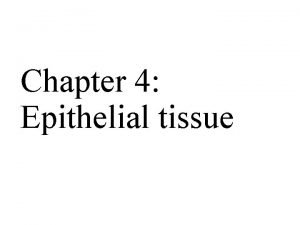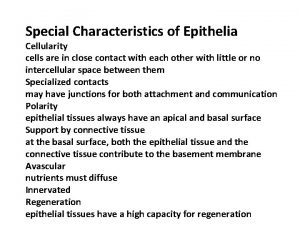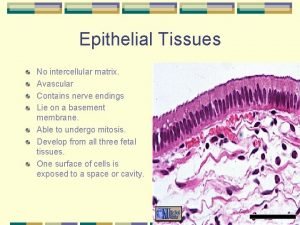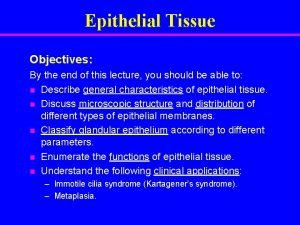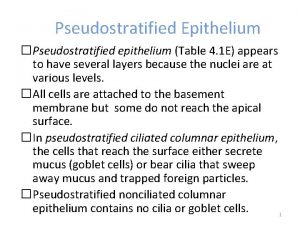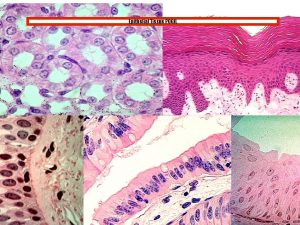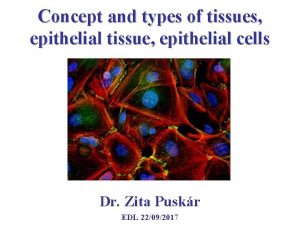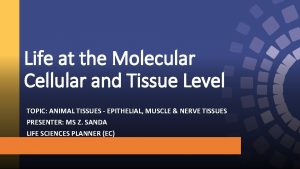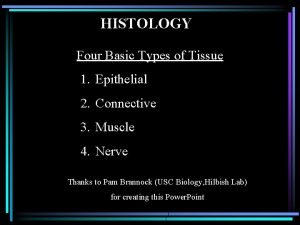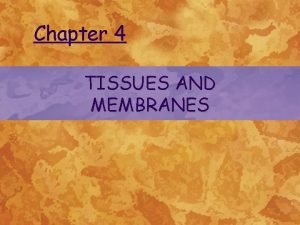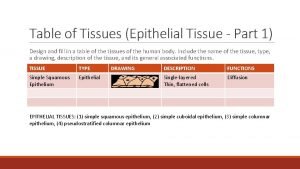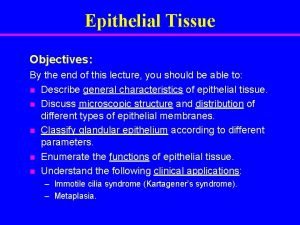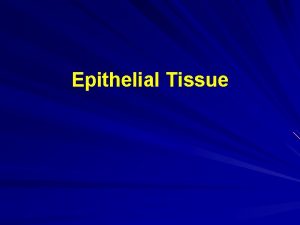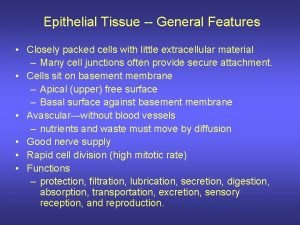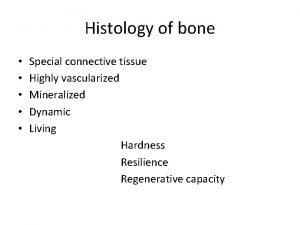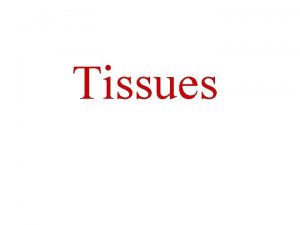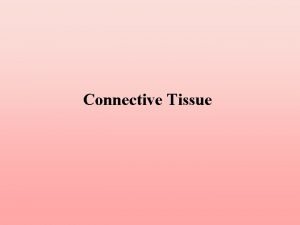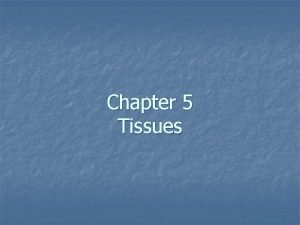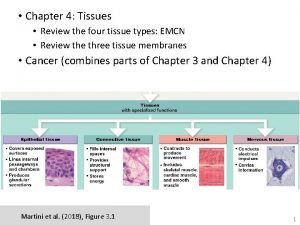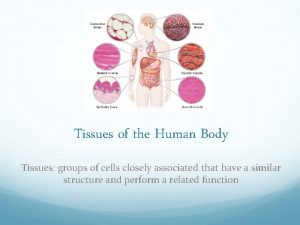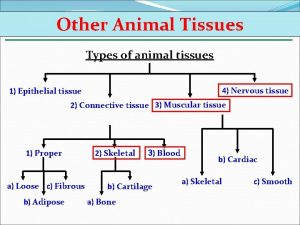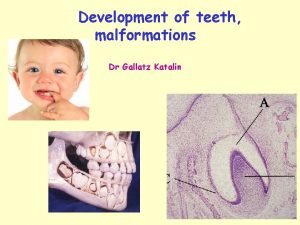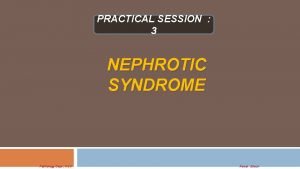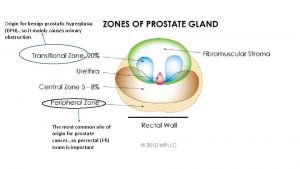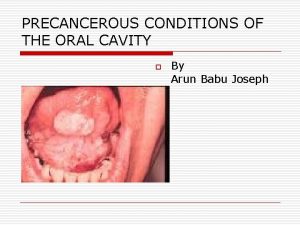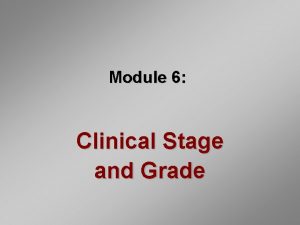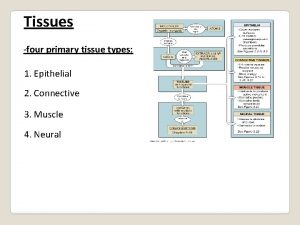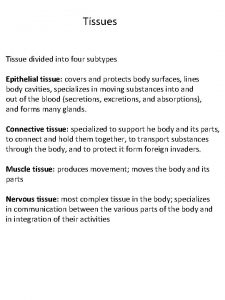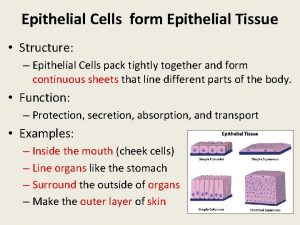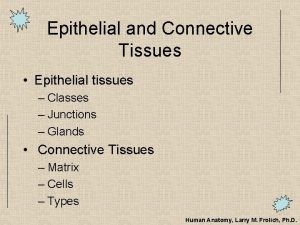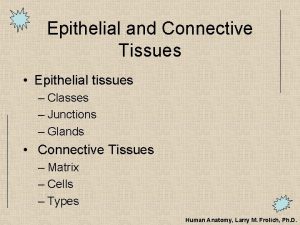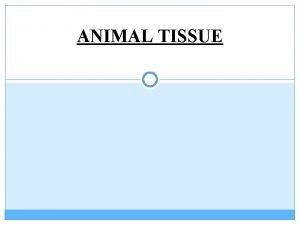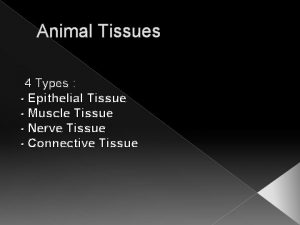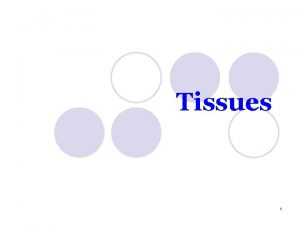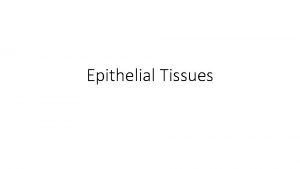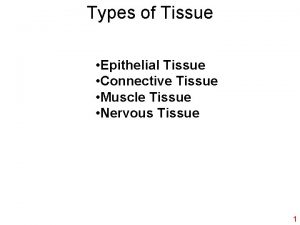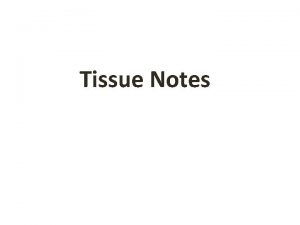Tissues four primary tissue types 1 Epithelial 2



























































- Slides: 59

Tissues -four primary tissue types: 1. Epithelial 2. Connective 3. Muscle 4. Neural

Membranes -many body structures and surfaces are covered with membranes -superficial sheet of epithelial cells + underlying connective layer -cover & protect -four types: 1. serous 2. mucous 3. cutaneous 4. synovial

Epithelial Tissue • • • divided into lining epithelium & glands lining epithelium = line body surfaces and cavities glandular epithelium = secretion • multiple functions of epithelial tissues: 1. protection - from dehydration, pathogens 2. synthesis – e. g. vitamin D 3. regulation - e. g. body temperature 4. excretion - e. g. waste 5. immune response 6. control of permeability – every substance must cross an epithelial membrane first 7. sensitivity – epithelial membranes are well-innervated

Epithelial characteristics 1. Cellularity 2. Polarity 3. Attachment 1. to each other 2. to connective tissue 4. Avascularity 5. Regeneration

Classification of Epithelia • catagorizing epithelial tissue types A. # of layers simple = 1 layer stratified = multiple **pseudo = 1 layer B. Cell shape columnar cuboidal squamous

Classification of Epithelia

1. Serous membranes -line the abdominopelvic cavity and thoracic cavity -covers, protects and moistens/lubricates -comprised of an epithelial layer known as simple squamous epithelium (mesothelium) + an underlying areolar connective tissue -the epithelium is “glued” onto the connective tissue by a thin layer made up of sugars and proteins = basal lamina mesothelium connective tissue

Simple Squamous Epithelium -tile-like cells - cells are thin, flat and irregular in shape = squamous -simple squamous - most delicate tissue in the body -found in protected regions where absorption occurs -many types: e. g. mesothelium - lines the abdomen e. g. endothelium - lines heart chambers and vessels

Loose connective tissues: Loose Areolar tissue -cells are mainly fibroblasts, spaced far apart -matrix: mostly ground substance + collagen fibers, elastic fibers -cushions and can be distorted due to loose organization e. g. found beneath the dermis connecting it to muscle and bone

1. Serous membranes -the epithelial component secretes a watery fluid = serous fluid (separates and lubricates the movement of organs) -divided into two separate layers: 1)outer parietal layer - lines the cavity 2) inner visceral layer - covers organs -serous membrane lining the pleural cavity (lungs) = pleura - serous membrane lining the pericardial cavity (heart) = pericardium - serous membrane lining the peritoneal cavity (abdomen) = peritoneum

2. Mucous membranes -line cavities that directly communicate with the exterior environment e. g. respiratory, urinary, reproductive, digestive -this membrane is also called a mucosa mucous membrane epithelium connective tissue -covers, protects and moistens/lubricates -also absorbs, filters and secretes -exposed epithelial surface is covered with a layer of mucous made by single cells called goblet cells or large multicellular mucous glands

-epithelial layer can take many forms a. simple cuboidal or simple columnar epithelium in areas with no physical stresses b. pseudostratified columnar epithelium – looks layered but is a single layer of cells c. stratified squamous epithelial tissue in areas of physical stress d. transitional epithelium – stratified epithelium found in areas of stretching

Simple Cuboidal Epithelium -cells are “cubes” with large, round nuclei -found in regions of secretion and absorption e. g. kidney tubules pancreas & salivary glands - buffers & enzymes thyroid follicles - thyroid hormones

Simple Cuboidal Epithelium

Simple Columnar Epithelium -height is greater than their width -oval shaped nuclei at basal end of cell -found in areas of absorption and secretion -located in the gallbladder, larger ducts of exocrine glands, gastric pits of stomach -frequently the apical face is modified with microvilli e. g. intestinal lining = brush border -short-lived cells – replaced every 4 to 5 days -frequently found with goblet cells (intestine and stomach)

Simple Columnar Epithelium microvilli

Pseudostratified Columnar Epithelium - only a single layer despite looking like many layers of cells -nuclei are at varying levels - appearance of multiple layers -BUT basal face of every cell contacts the basement membrane -exposed apical surface typically bears cilia e. g. respiratory epithelium

Pseudostratified Columnar Epithelium


Transitional Epithelium -stratified squamous epithelium that permits stretching -actual number of layers can be seen upon stretching -located in walls of the bladder, renal pelvis and the ureters -cells in deep layers can be columnar -transition to cuboidal towards surface

Transitional Epithelium

3. Synovial membranes -extensive areas of areolar connective tissue covered by incomplete layers of simple squamous or cuboidal epithelial cells -lines & lubricates the synovial joint cavity - to permit easy movement of bones -considered by some to be a type of serous membrane -BUT the epithelium differs from others: 1) there is no basal lamina 2) incomplete cellular layer - gaps between cells -some cells within this membrane are phagocytic to remove pathogens -others are secretory - secrete a watery synovial fluid for lubrication

4. Cutaneous membrane (skin) -covers the surface of the body -epithelial layer (keratinized stratified squamous epithelium) = Epidermis -underlying areolar connective tissue reinforced with dense irregular connective tissue = Dermis -underlying layer of areolar connective tissue and adipose tissue = Hypodermis

The skin: The Cutaneous Membrane • skin covers the entire body surface -including the anterior surface of the eye! -covers ~ 22 square feet -about 16% of total body weight • skin turns in at the mouth, nasal cavity, anus, urethral and vaginal openings – meets the mucous membranes lining these cavities • no “break” between the outer cutaneous and inner mucous membranes • 1 st line of defense against pathogens

The skin: The Cutaneous Membrane • comprised of all four tissues: 1. epithelium – lines the inner and outer surfaces of body 2. connective – provides strength & resiliency 3. muscle – smooth muscle controls blood vessel diameter and controls movement of hairs 4. nervous – provides sensation and controls SM

The Skin: functions 1. physical protection: protection from microbes, abrasion, heat 2. chemical protection – keratin - dryness of the epidermis; salt of sweat 3. regulation of water exchange: by sweating 4. regulation of body temperature: thermoregulation -by sweating & adjusting blood flow through the dermis 5. excretion of wastes -by sweating 6. nutrition – synthesis of vitamin D precursor -activated in skin, converted to calcitrol in liver 7. sensation: touch, pressure, vibration, pain & thermal 8. immune defense: Langerhans cells of the epidermis

The Integumentary System -two major components: 1. cutaneous membrane = skin (epidermis, dermis) 2. accessory structures = hair, nails, exocrine glands

Epidermis -stratified squamous epithelium - 5 layers maximum -four types of cells: 1. keratinocytes – make up the majority of the epidermis -epithelial cells that synthesize the protein keratin 2. melanocytes – cells for the synthesis of the light absorbing pigment melanin 3. Merkel cells – neurons that detect pressure 4. Langerhans cells – immune responses

Epidermis: layers - stratum germinativum or stratum basale: -inner most/deepest layer of the epidermis - contains basal cells called stem cells that differentiate into the keratinocytes and melanocytes of the epidermis -contains melanocytes for the production of melanin -neurons called Merkel cells are found in hairless regions for detection of pressure and touch

Epidermis: layers - stratum spinosum: -keratinocytes of the stratum basale migrate up into this layer after dividing -several layers thick of viable keratinocytes beginning the production of keratin -cells can divide - division of cells within this layer increases thickness -Langerhans cells found in the deeper layers of this section initiate immune responses to pathogens and to cancer

Epidermis: layers -stratum granulosum: -made up of keratinocytes migrating up from the stratum spinosum -cells contain large quantities of proteins (including keratin) – cytoplasm appears granular -the granules = keratohyalin granules - the cells die and dehydrate in this layer

Epidermis: layers -stratum lucidum: -covers the Str. Gran. -flattened, densely packed cells filled with keratin -have a glassy appearance because they do not stain well -present only in the skin of fingertips, palms & soles of feet = THICK SKIN A. stratum corneum C. stratum D. spinosum granulosum B. stratum lucidum C. D. stratum spinosum granulosum E. stratum basale ONLY FOUND IN THE PALMS OF THE HAND SOLES OF THE FEET

Epidermis: layers - stratum corneum: -cornu = horn -makes up outer surface of both thick and thin skin -15 -30 layers of flattened, dead, interlocking cells -large amounts of keratin are present – the tissue is said to be “cornified” -covered in secretions from dermal glands to help moisturize the outer layer -but keratin makes this layer water-resistant - very dry to prevent growth of microorganisms

Epidermis: layers - stratum corneum: -most of this layer is hydrophobic -penetration is promoted by attachment to a lipid or dissolution in a lipid-based solution -transdermal drug patches – drugs are in oils or lipid-soluble carriers - moisturizing lotions – only penetrate few first layers of corneum -takes 15 -30 days to move from germinativum to corneum -cells will remain in corneum for an additional 2 weeks before being shed

Dermis -two major components: 1. papillary layer 2. reticular layer

Dermis Papillary Layer -about 1/5 th thickness of dermis -loose areolar connective tissue + elastic fibers -numerous capillaries & sensory nerve endings -dermal projections into the epidermis = dermal papillae (papilla – “nippleshaped mound) -some papillae contain Meissner’s corpuscles for touch -also free nerve endings – project into the epidermis - sensations of pain, warmth, itching dermal papilla

Dermis Reticular Layer (“little net”) -dense irregular connective tissue – interwoven collagen bundles plus elastic fibers in an irregular pattern -reticular layer contains blood vessels, nerves, hair follicles, sweat glands and sebaceous/oil glands -also contains lamellated corpuscles (Pacinian corpuscles) that detect deep touch and pressure Dense irregular connective tissue

Fingerprints: epidermal ridges -formed from the stratum germinativum -extends down into the dermis -formed by the connections between dermal papillae and the epithelium -the contours of the skin follow these ridge patterns = fingerprints -function to increase the SA of the skin and increase friction

Skin colour 1. dermal blood supply: - hemoglobin bound to O 2 – bright red in color so it gives pinkish cast to skin -when hemoglobin lacks O 2 – bluish colour -this bluish skin colour = “cyanosis” -the thin skin of the lips and transparency of the nail enables us to see the blood in the peripheral circulation = red lips and pink nails -dermal blood supply comes from the larger blood vessels found in the subcutaneous layer called the hypodermis

Skin colour 2. pigmentation – two pigments: carotene and melanin -carotene = orange, yellow colour -derived from vitamin A beta carotene - required for epithelial maintenance -carotene accumulates in keratinocytes -yellow color is very evident in the stratum corneum

Skin colour 2. pigmentation – two pigments: carotene and melanin -melanin = dark brown, black colour -synthesized from the amino acid tyrosine -melanin absorbs UV light and prevents damage to the keratinocytes of skin -produced and secreted by the melanocytes of the epithelium -melanin is transferred into the keratinocytes -light skin – melanin transfer occurs to keratinocytes only in the Str. germ. and Str. spinosum -dark skin - larger melanosomes and melanin transferred into the Str. granulosum dark skin = more active melanocytes – NOT more in number!

Hypodermis -also referred to as the subcutaneous layer or superficial fascia -connects the skin to underlying muscles or other organs -made up of: 1. loose connective tissue 2. adipose tissue - “baby fat” - also contains elastic fibers for flexibility -contains large arteries and veins – supply the dermal plexuses with blood -the superficial layers of the hypodermis are the sites for drug injections hypodermic

Loose connective tissue: Adipose tissue -cells = adipocytes -cushions joints and organs -stores energy -insulates -in the hypodermis – adipose tissue is found intermixed with areolar tissue

Loose connective tissue: Adipose tissue -fat distribution changes with age and gender: -males – neck, upper arms, abdomen and lower back -females – breasts, abdomen, buttocks, hips and thighs

Wrinkles: reduction in the thickness of the dermis SOME FUN STUFF TO KNOW -loss of collagen in the dermal reticular layer ABOUT SKIN -loss in dermal flexibility = wrinkles and sagging Scars: from greek word schara (place of fire) -damaged dermis is replaced with tissue of inferior quality and rich in collagen -scars do not have sweat or oil glands and do not have hair -redness of the scar is due to inflammation and is not permanent - two common types: 1. hypertropic (red and raised, do not grow beyond boundaries of original wound 2. keloid – permanently growing scars – can lead to benign tumors - more common in darker skin, common on chest and shoulders Stretch marks: extensive and quick distortion of the dermis damages it -no recoil of skin after stretching -leads to breaking of elastic and collagen fibers in the dermis - replaced with new, poorly organized collagen Retin-A (tretinoin) : increases blood flow to the dermis -promotes dermal repair -decreases wrinkles and stretch marks

Accessory Structures of the Integumentary System Hair follicles Sweat glands Sebaceous/Oil glands Nails

Hair & Hair follicles • over all epidermal surfaces except soles of feet, palms of hand, sides of fingers and toes and portions of external genitalia • approx. 5 million hairs on the body • formed in and protected by structures known as hair follicles

Hair • Comprised of three major regions: 1. Hair bulb – contains the hair matrix – living cells undergoing division and keratin formation 2. Hair root – site of connection with arrector pili (smooth muscle) and a sebaceous gland (oil gland) 3. Hair shaft – portion of the hair above the sebaceous gland -portion of it is exposed above the skin • made up of an outer cortex and inner medulla of keratin -cortex – hard keratin - stiffness -medulla – soft keratin – flexible matrix

Hair • made up of an outer cortex and inner medulla of keratin -cortex – hard keratin - stiffness -medulla – soft keratin – flexible • outer most layer is made up of several layers of dead cells - cuticle

Hair follicle -found in the dermis -organ that makes the hair -surrounds and protects the hair bulb, root and shaft -made up of several layers

Exocrine Glands • • • skin is kept moist through the secretion of oil skin is cooled through the evaporation of sweat secretion is done via exocrine glands exocrine gland – gland that secretes out onto an epithelial tissue such as the skin most exocrine glands secrete via tubes called ducts

Exocrine Glands • exocrine secretions: 1. perspiration 2. digestive enzymes 3. milk 4. mucous 5. oil

Exocrine Glands • you can classify exocrine glands many ways • one way – by the consistency of what they secrete – e. g. serous, mucous, mixed • another way – by their structure – e. g. multicellular, unicellular • last way – by the mode of secretion – e. g. holocrine, merocrine, apocrine

• exocrine gland types – consistency of secretion: 1. serous - watery fluid that contains enzymes e. g. saliva – parotid salivary gland 2. mucous - glycoproteins called mucins that absorb water to form a slippery mucus e. g. sublingual salivary gland 3. mixed - more than one type of gland cell -produces different types of secretions - mucus and serous e. g. submandibular salivary gland

Skin glands 1. Sweat/Sudoriferous – of the serous type 2. Oil/Sebaceous – of the mucus type 3. Wax/ Ceruminous

Sebaceous/Oil Glands (Mucous Glands) -”sebace” = greasy -oil is also called sebum -secreting portion is within the dermis -most open onto hair follicles -glands located at the lips, glans penis, labia minora and eyelids - open directly to the skin surface -absent on palms and soles -large in size and numbers on breast, face, neck and upper chest

Sudoriferous/Sweat Glands (Serous. Glands) • 3 to 4 million glands in the body • sudori = sweat, ferous = bearing • released by exocytosis into hair follicles or onto the skin surface via a pore • two types: – 1. Merocrine (eccrine) – secrete watery sweat through a skin pore – 2. Apocrine – secrete an odiferous, oily sweat onto a hair

• Mammary glands – large, complex apocrine sudoriferous glands – divided into lobules made up of secretory alveoli

• Ceruminous glands • modified sweat glands • found in the ear canal • secretory portion is in the SQ layer, deep to sebaceous glands • secrete either directly into the ear canal or into the ducts of the sebaceous glands • produce waxy cerumin - together with the hairs of the canal provides protection
 Body tissue
Body tissue 4 primary tissue types
4 primary tissue types Body tissues chapter 3 cells and tissues
Body tissues chapter 3 cells and tissues Eisonophil
Eisonophil Anatomy chapter 3 cells and tissues
Anatomy chapter 3 cells and tissues Types of tissue
Types of tissue What are the four primary tissue types
What are the four primary tissue types Tissue
Tissue Layers of epithelial tissue
Layers of epithelial tissue Transitional epithelium
Transitional epithelium Epitelio glandular holocrino
Epitelio glandular holocrino Tecido
Tecido Epithelial tissue
Epithelial tissue Epithelial tissue
Epithelial tissue Layers of epithelial tissue
Layers of epithelial tissue Cell shape
Cell shape Passageway
Passageway Epithelial tissue avascular
Epithelial tissue avascular Characteristics of epithelial tissue
Characteristics of epithelial tissue Tissues anatomy
Tissues anatomy Stratified columnar epithelium
Stratified columnar epithelium Characteristics of epithelial tissue
Characteristics of epithelial tissue Epithelial tissue histology pogil
Epithelial tissue histology pogil Epithelial tissue
Epithelial tissue Identify the tissue
Identify the tissue Epithelial tissue
Epithelial tissue Animal tissue
Animal tissue Glandulas
Glandulas Exoepithelial
Exoepithelial Cow nerve cell
Cow nerve cell Protein fibers in connective tissue
Protein fibers in connective tissue Table tissue design
Table tissue design Function of epithelial tissue
Function of epithelial tissue Histology
Histology Closely packed cells
Closely packed cells Concentric lamellae vs circumferential lamellae
Concentric lamellae vs circumferential lamellae Class 1 canine relationship
Class 1 canine relationship Four major tissue types
Four major tissue types Hyaline cartilage location
Hyaline cartilage location Four principal types of tissue
Four principal types of tissue What are the primary tissue types
What are the primary tissue types What are the 4 types of tissues
What are the 4 types of tissues Types of tissues
Types of tissues Types of tissues
Types of tissues Perforation plates
Perforation plates Casts in urine
Casts in urine Epithelial dysplasia oral
Epithelial dysplasia oral Transseptal fiber
Transseptal fiber Schema tissu epithelial
Schema tissu epithelial Reduced enamel epithelium
Reduced enamel epithelium Simple cuboidal epithelium
Simple cuboidal epithelium Carcinoma
Carcinoma Gustatory epithelial cells
Gustatory epithelial cells Simple columnar epithelium
Simple columnar epithelium Squamous cell carcinoma
Squamous cell carcinoma Sialedinitis
Sialedinitis Testis
Testis Vanesa gregorc
Vanesa gregorc Differential diagnosis of osmf
Differential diagnosis of osmf Bowel cancer stages
Bowel cancer stages





